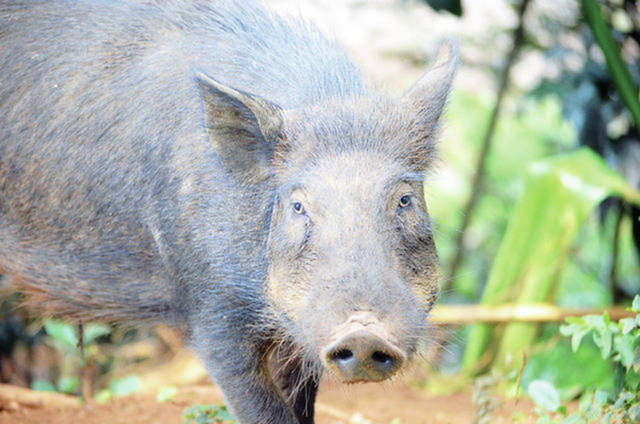They are mainstays for luaus and centerpieces in photos, reminiscent of a few characters in movies and just as destructive as their cartoon counterparts. They are feral pigs on the Garden Island.
As with Hawaii Island, and many of the other islands in the archipelago, the exact number of pigs is nearly impossible to discern, and fluctuates depending on the time of year and environmental conditions.
Availability of water, food, terrain and pressure from hunting all have an impact on the population and distribution, according to Hawaii’s Department of Land and Natural Resources’ Division of Forestry and Wildlife.
“The best we can do is estimate distribution and impacts caused by pigs,” said David Smith, administrator of DLNR’s DOFAW.
Impacts like uprooting parts of trees and underground plants, eating understory plants and creating opportunities for invasive species, and raiding farms for food can cause native forests to change and those in agriculture to lose money.
Lee Roversi, of North Country Farms in Kilauea, has felt some of those impacts as a large pig population tends to take up residence at a property near her farm.
“I’ve lived at my farm for over 30 years and the past three years I’ve seen and experienced more pig activity than ever,” Roversi said.
She believes the older boars in the herd that lives down the road push the younger boars out and those animals wander over to her property.
“Every pig we’ve managed to snare on our property has been a young, yearling male,” she said. “If we had a sunset hunt, how many families would that feed?”
Hunting, trapping and fencing keeps the populations in check, according to DOFAW — at least in some areas. But in places where food and water is abundant and the population is protected from hunters, it can get out of hand.
“Pigs are extremely prolific. It is estimated that you have to remove 70 percent of the population each year just to keep the population from growing,” said Smith.
In some areas, public hunting keeps pigs at an “acceptable level,” DOFAW says. Currently, there are more than 2,500 licensed hunters on Kauai — though for farmers and conservationists, that might not be enough.
“If your goal is the protection and management of native ecosystems, or farming, more intensive trapping and hunting programs may be needed,” Smith said.
That kind of trapping and fencing has been happening in places like the Alakai Wilderness Preserve and Hono O Na Pali Natural Area — all of which are managed through liberal public hunting, staff control and ungulate exclusion fences.
However, there isn’t an island-wide pig management plan due to the wide variety of ownership on the island.
Partnerships between the state and groups like the Kauai Watershed Alliance, Kauai County Water Department and The Nature Conservancy, as well as with individuals, help keep the feral animals under control.
“Increasing collaboration with private landowners to provide hunter access on private lands would help to further reduce pig populations in specific areas,” Smith said.
The story isn’t a new one. Pigs could be either a blessing or a curse depending upon who is speaking, according to Makani Christensen, of the Hunting Farming and Fishing Association.
“Some say it’s too many and it’s overrun. Hunters say it’s a good thing, because it’s a food source,” he said.







The feral pig population is growing exponentially.
Let’s assume there are 250,000 feral pigs (FIGS) on the island which is a conservative estimate. Therefore, we need to kill 70% or 175,000 FIGS this year to keep the population level at 250,000 for next year.
Suppose we only kill 100,000 Figs (that’s 1 pig per every local on Kauai))? Next year we will have 600,000 Figs.
Then the following year we kill another 100,000 Figs? We have 1,500,000 Figs.
The Figs are growing exponentially. If we have 250,000 pigs today, in two years we will have 1,500,000 Figs…
The article “Feral pig population holding steady” simply reflects the State and County government position of “Doing Nothing”.
Jessica, you really danced around the story of the controversial wild boar refuge run by Bev Harter on the corner of Kuhio Highway and South Waiakalua Street in Kilauea, as alluded to by Lee Roversi. It is ludicrous to allow a private property owner to feed wild animals on a daily basis and encourage over-breeding. The lack of consideration for those negatively impacted by these animals is outrageous. When some tourist group attracted by the sight of the hundreds of wild boar in the Harter horse pasture causes a serious, or deadly, accident on the highway, who will be held responsible/ The drivers? Ms. Harter? Or the authorities who, despite being aware of the dangers for years, did nothing ?
As for the hunters who love pig overpopulation and easier pickings, get up for a bit more of a challenge. My understanding is that there are far more feral pigs on the island than there are human beings!
Where on island is the largest population problem?